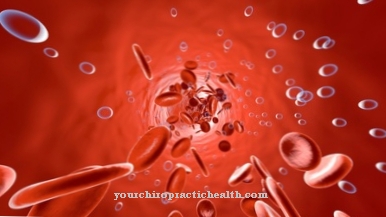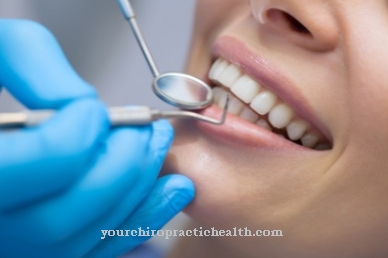The most easily constructed reflex in medicine is called Self-reflex designated. The reflex occurs at the same point at which it was triggered. An example of this is the patellar tendon reflex in the area of the kneecap, which is caused by a light blow on it.
What is a self reflex?

In the case of self-reflex, the reaction is produced exactly where the stimulus took place. The term comes from neurophysiology and usually refers to muscle reflexes. If a muscle is stretched by a stimulus, this leads to a twitch of the stimulated muscle via synapses and connections in the spinal cord.
How strong the reaction is depends on the reflex arc and the state of the motor neuron in the spinal cord. The self-reflex, however, cannot be changed. It can be influenced by exercises, increased attention or appropriate tension of the muscles. In addition, in some cases it can be completely absent.
In contrast to the external reflex, the self-reflex cannot be habituated. This is what medicine describes as getting used to a stimulus. The reactions are not weakened by repetition in the case of self-reflexes, or they do not occur at all. He is not tired.
It also has a short latency period. Because of the less complex branching, the reaction takes place immediately and without any major delay. With the external reflex, on the other hand, the nerves only switch to other organs or muscles in the spinal cord, which in turn react to the reflex. An example of this is checking the pupillary reflex when there is suspicion of brain damage. Incidence of light in one eye usually narrows both pupils.
Function & task
The list of self-reflexes is long. Some are used by doctors to test the function of various spinal cord nerves. Self-reflexes fulfill various tasks, whereby these are usually protective mechanisms. The stretch reflexes protect people from falling, for example, as is the case with the PSR (patellar tendon reflex). If the knee buckles, the lower leg is reflexively moved to snap forward, which can prevent a fall by stabilizing the balance. So it is a matter of performing a swift routine task. The short latency period is therefore necessary. The own reflexes thus fulfill a vital function.
The so-called reflex arc consists of a receptor - the sensory organ - the nerve fiber involved, the central nervous system as well as the motor fiber and the effector. The effector is the muscle or organ that carries out the response to the stimulus. In the case of self-reflex, the receptor and effector are identical according to the explanation given above. Triggering stimuli can be, for example, pull, acceleration, pressure, sound, temperature, light or chemical substances.
In the following, some of the self-reflexes are taken up to illustrate the function and reaction. In the case of the Achilles tendon reflex, for example, a slight blow on the tense Achilles tendon triggers a reaction of the ankle joint. The abdominal wall reflex reacts to the placing of fingers on the abdominal muscles and a blow on the back of the fingers. The tensing of the abdominal muscles caused by this, for example, is a mechanism that protects against damage to internal organs when thudding thuds in the abdominal area. Hitting the chin in turn triggers the automatic closing of the mouth to prevent damage to the mouth.
However, there are also reflexes that only occur when damage to the central motor system has occurred. This includes, for example, the toe flexion reflex, which occurs when the toe berries are hit briefly and forcefully. Flexing the toes indicates injury.
Illnesses & ailments
Damage to nerves or the spinal cord can therefore affect the reflexes. For example, damage to the first motor neuron leads to a strong increase in reflexes. This also includes the toe flexion reflex. However, if there is damage within the reflex arc, the reflex fails completely. This can be the case due to mechanical damage or neuritis. A detailed neurological examination can be used to find out whether individual nerve tracts are damaged or whether there is nerve dysfunction. After a stroke, the reflexes of muscles can increase. Doctors refer to such misconduct as spasticity. External reflexes in neighboring muscle groups are also possible.
In addition to the toe flexion reflex, the so-called adductor reflex (ADR) also provides information about diseases. If a blow is exerted on the tendons on the inside of the thigh bone at the knee joint, the leg reacts with adduction in the hip. If the reflex is increased, both legs react to the one-sided stimulus as is the case with the reaction of both eyes to light conditions. The nerve pathways L2, L3 and L4 as well as the obturator nerve are responsible for ADR. This is a lumbar plexus nerve.
In the case of a herniated disc, the Achilles tendon reflex can also fail if the roots are compressed. The orbicularis-oris reflex leads to the trunk-like protrusion of the lips when the muscles of the mouth are tapped. This reflex is a sign of muscle over-excitability and can occur, for example, in tetany.
Not every lack of a self-reflex is based on a disease. There are some reflexes that are close to the threshold and therefore cannot always be triggered. In case of doubt, a doctor will use further tests to reliably diagnose illnesses.






.jpg)




















